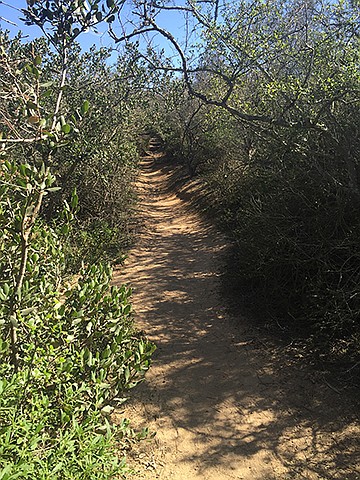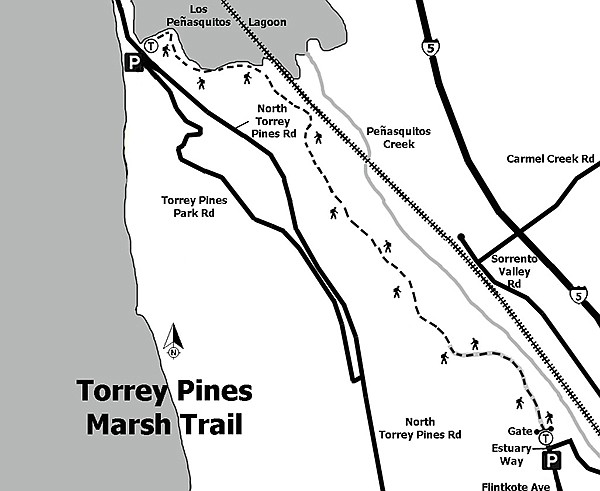 Facebook
Facebook
 X
X
 Instagram
Instagram
 TikTok
TikTok
 Youtube
Youtube

The Torrey Pines Marsh Trail is not easily found, much like the cave of the hermit who carved a home out of the sandstone bluffs along the trail. The Marsh Trail does not appear on all maps of the reserve’s trails, but it does exist and is shown on some of them. It begins east of the Torrey Pines State Natural Reserve lower parking lot, across Torrey Pines Road from the reserve’s main entrance. Only about the first half-mile of the trail lies within the reserve’s boundary, after which it continues along the southeastern edge of Los Peñasquitos Salt Marsh Preserve, also a state-protected natural area. The trail continues for about 2 miles to the intersection of Flintkote Avenue and Estuary Way in Sorrento Valley and is sometimes referred to as the Flintkote Trail. The trail isn’t officially marked beyond a few signs indicating that dogs, bikes, horses, camping, nor fires are allowed.

From the Torrey Pines trailhead, visitors descend a good 20 feet from the highway onto a sandy mesa that is thought to be a relic sand dune formed before the construction of the Pacific Coast Highway. The vegetation is typical coastal sage scrub and includes California sagebrush, black sage, chamise, and lemonade berry.
As the trail descends toward the wetlands, the plant community changes from sage scrub into a marsh habitat with small, branched succulents. At high tide this portion of the trail may be underwater, so be prepared to get your feet wet. Even at low tide the trail can be muddy. Keep an eye out for birds. In addition to migratory waterfowl, snowy egrets, great egrets, and great blue heron are frequently spotted. And, with luck, fish in the deeper channels may be seen.
Along the marsh sections, visitors will find halophytes — pickleweed (also known as glasswort because it was once a source of salt for making glass), salt grass, and alkali-heath — lining the trail. These plants have a high tolerance for both alkaline environments and drought and use clever strategies for survival, like storing excess salt in their fleshy tissues. Other plants found here include several kinds of cactus, the most abundant of which are the pancake prickly-pear and coast cholla. If you look closely, you might also see the less common coast barrel cactus and golden-club cactus. Only cholla cactus has paper sheaths covering their spines — be careful if attached to your skin, as parts of the sheaths can remain.

The trail continues for about 2 miles, ending at the second entrance along Flintkote Avenue in Sorrento Valley, which is the turnaround point if you began your journey from the Torrey Pines entrance. This section of the marsh is mostly fresh water, which is reflected by the lack of halophytes and the return of sage-scrub plants. Visitors will need to be cautious when nearing the trail’s end, as this section of the path is riddled with erosion, leaving several large open sinkholes along its edges.
Even with the mud and erosion, the Marsh Trail is worth a visit for bird lovers, native-plant aficionados, and day-hikers. As to the hermit and the location of his cave? He passed away in 1994 and his cave sanctuary was sealed off with cement.
A hike so close to the estuary that your toes could get wet
Distance from downtown San Diego: approximately 17 miles. Allow 30 minutes driving time (La Jolla). From I-5, go west on Carmel Valley Road for 1.6 miles. Turn left on South Camino Del Mar, which becomes North Torrey Pines Road as you cross into La Jolla. Go 0.9 mile to the park entrance to pay a day-use fee and then turn left and park in the lot. The parking area has facilities, but there are no facilities along the trail. Note: The trail starts almost directly across N. Torrey Pines Road from the entry of the parking lot. Take extreme care crossing the road. A safer route would be to start at the intersection of Flintkote Avenue and Estuary Way.
Hiking length: approximately 4 miles out and back.
Difficulty: Moderate, due to erosion on parts of the trail and areas overgrown with vegetation. Elevation gain/loss is less than 100 feet. This trail is a wildlife preserve and is not maintained. No dogs, bikes, horses, or fires are allowed.


The Torrey Pines Marsh Trail is not easily found, much like the cave of the hermit who carved a home out of the sandstone bluffs along the trail. The Marsh Trail does not appear on all maps of the reserve’s trails, but it does exist and is shown on some of them. It begins east of the Torrey Pines State Natural Reserve lower parking lot, across Torrey Pines Road from the reserve’s main entrance. Only about the first half-mile of the trail lies within the reserve’s boundary, after which it continues along the southeastern edge of Los Peñasquitos Salt Marsh Preserve, also a state-protected natural area. The trail continues for about 2 miles to the intersection of Flintkote Avenue and Estuary Way in Sorrento Valley and is sometimes referred to as the Flintkote Trail. The trail isn’t officially marked beyond a few signs indicating that dogs, bikes, horses, camping, nor fires are allowed.

From the Torrey Pines trailhead, visitors descend a good 20 feet from the highway onto a sandy mesa that is thought to be a relic sand dune formed before the construction of the Pacific Coast Highway. The vegetation is typical coastal sage scrub and includes California sagebrush, black sage, chamise, and lemonade berry.
As the trail descends toward the wetlands, the plant community changes from sage scrub into a marsh habitat with small, branched succulents. At high tide this portion of the trail may be underwater, so be prepared to get your feet wet. Even at low tide the trail can be muddy. Keep an eye out for birds. In addition to migratory waterfowl, snowy egrets, great egrets, and great blue heron are frequently spotted. And, with luck, fish in the deeper channels may be seen.
Along the marsh sections, visitors will find halophytes — pickleweed (also known as glasswort because it was once a source of salt for making glass), salt grass, and alkali-heath — lining the trail. These plants have a high tolerance for both alkaline environments and drought and use clever strategies for survival, like storing excess salt in their fleshy tissues. Other plants found here include several kinds of cactus, the most abundant of which are the pancake prickly-pear and coast cholla. If you look closely, you might also see the less common coast barrel cactus and golden-club cactus. Only cholla cactus has paper sheaths covering their spines — be careful if attached to your skin, as parts of the sheaths can remain.

The trail continues for about 2 miles, ending at the second entrance along Flintkote Avenue in Sorrento Valley, which is the turnaround point if you began your journey from the Torrey Pines entrance. This section of the marsh is mostly fresh water, which is reflected by the lack of halophytes and the return of sage-scrub plants. Visitors will need to be cautious when nearing the trail’s end, as this section of the path is riddled with erosion, leaving several large open sinkholes along its edges.
Even with the mud and erosion, the Marsh Trail is worth a visit for bird lovers, native-plant aficionados, and day-hikers. As to the hermit and the location of his cave? He passed away in 1994 and his cave sanctuary was sealed off with cement.
A hike so close to the estuary that your toes could get wet
Distance from downtown San Diego: approximately 17 miles. Allow 30 minutes driving time (La Jolla). From I-5, go west on Carmel Valley Road for 1.6 miles. Turn left on South Camino Del Mar, which becomes North Torrey Pines Road as you cross into La Jolla. Go 0.9 mile to the park entrance to pay a day-use fee and then turn left and park in the lot. The parking area has facilities, but there are no facilities along the trail. Note: The trail starts almost directly across N. Torrey Pines Road from the entry of the parking lot. Take extreme care crossing the road. A safer route would be to start at the intersection of Flintkote Avenue and Estuary Way.
Hiking length: approximately 4 miles out and back.
Difficulty: Moderate, due to erosion on parts of the trail and areas overgrown with vegetation. Elevation gain/loss is less than 100 feet. This trail is a wildlife preserve and is not maintained. No dogs, bikes, horses, or fires are allowed.
Comments